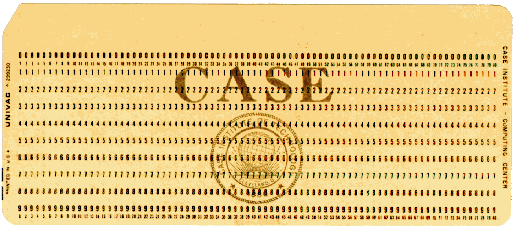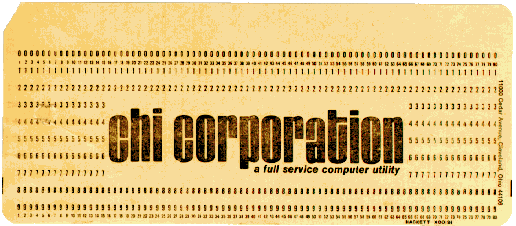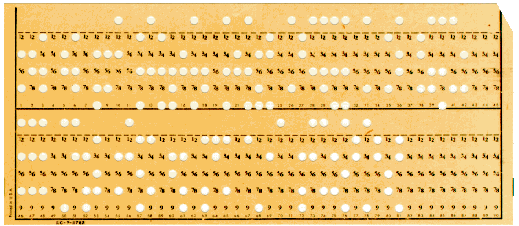
Punch cards (UNIVAC® programmers would never refer to them as “IBM cards”!) were not only the primary medium used to create programs in the mainframe era, they were also the bookmark, notepad, and Post-it® notes of the programmers who used them on a daily basis. It is largely due to these secondary applications that the following punch cards have survived into the present.
These cards were sold at the main office of the Andrew R. Jennings Computing Center of the Case Institute of Technology, and a generation punched their first programs onto them, usually written in Algol for the Case UNIVAC 1107.

In 1967, Case Institute of Technology shut down the 1107 and spun off its main computing facility as a private “computing utility” (a buzz word of the time bearing the same cachet “Internet Commerce Server” has at this writing) which provided the university computing services as its “base load customer”.
When Chi first opened, it had an extremely fussy logo in which the Greek letter Chi (for X—the unknown, since the project to spin off the computing centre was originally called “Project X”) and “Chi” written in script, all made up of ones and zeroes. However elegant, this was very difficult to reproduce on less than perfect paper and just wasn't “with it” enough for the go-go Sixties. So, before long, it was jettisoned for a bold sans-serif logo which was printed in green on stationery. Here's a punch card from that era.

In the electromechanical tabulator era, long before electronic computers, IBM locked up Herman Hollerith's patents on the punch card. This deprived competitors of access to the medium in which the vast majority of machine-processed documents were originated and maintained. Remington Rand, which acquired the UNIVAC computer family from the Eckert-Mauchly Computer Corporation, had a well-established line of tabulating machinery that dodged the IBM Hollerith patents by using 90 column cards with round holes, punched by mechanical punches that punched the entire card at once (and hence allowed correction of errors before the card was punched, unlike IBM gear where one quickly learned, “You can't erase a hole”). Once UNIVAC obtained patents on the key technologies of electronic computing, they were able to license these patents to IBM in return for the rights to the 80 column Hollerith card (which, in retrospect, was not a terribly good idea, strategically speaking), and the Hollerith card became the mainstream input medium for UNIVAC computers.
But if you've designed your whole corporate data processing system around 90 character records, it's very difficult to just lop off the last 10. Early adopters of Remington Rand tabulators and UNIVAC computers continued to soldier along with 90 column cards well into the 1970's. Here's an example I punched in 1972 on a 1930's vintage Remington Rand keypunch while I was employed at Vickers division of Sperry Rand in Troy, Michigan, in the United States.

Interestingly, the 90 column card used a binary character code which was far more efficient and computer-oriented than IBM's Hollerith code. In fact, when IBM introduced the regrettable 96 column punch card in the 1970's, it resembled nothing so much as a shrunken UNIVAC 90 column card. If you ever drove on the New Jersey Turnpike in the eastern United States in the 1960's or early 70's, you may recall the ticket you were handed when you entered, which had to be presented at the toll booth when you left: it was a 90 column UNIVAC card.